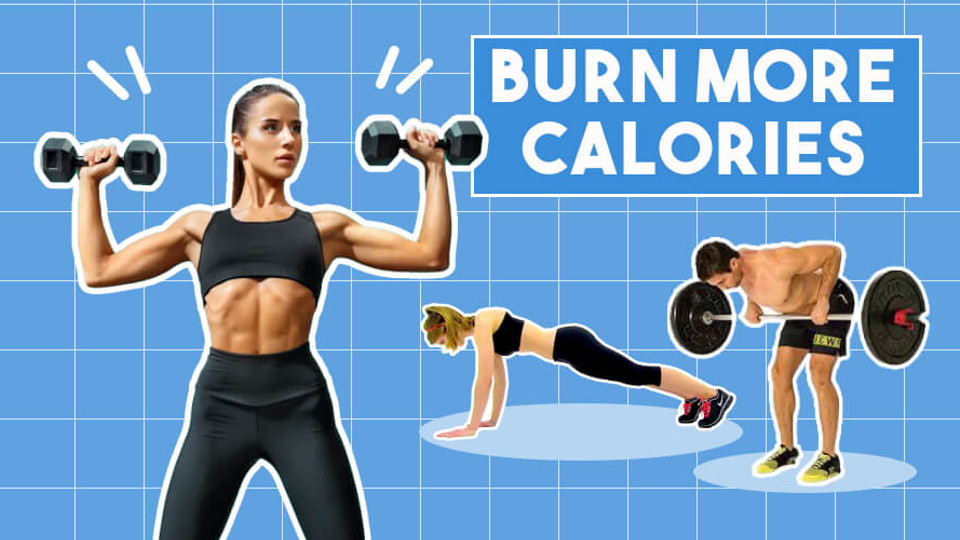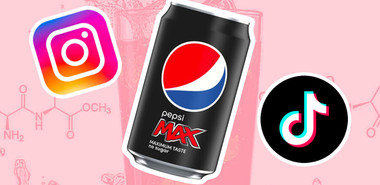
Looking to lose weight or simply improve your overall fitness?💪One key component (alongside a good diet) to reaching your goals is finding exercises that effectively burn calories. Incorporating calorie-burning exercises into your fitness routine can not only help you lose weight but also boost your metabolism and improve your cardiovascular health.
In this blog, we’re doing a deep dive into the best exercises for burning calories and maximising your weight loss efforts. We’ve scoured the internet and social media to see what the pros have to say (personal trainers) – is high-intensity interval training best for burning calories? Is it weight lifting? We’ve got the answers, and we’re gonna share them with you right here and now. We’ll be looking at four types of exercises:
- HIIT (High-Intensity Interval Training) 👊🏼
- Weight Lifting 🏋️
- Cardio 🏃
- Strength Training 💪
But First, Which Exercise Burns the Most Calories
The below breakdown is how many calories the average person would burn doing the following exercises. We’ve taken the data from MyFitnessPal and we’ve assumed a weight of 70kg male.
-
Walking 210 calories per hour
-
Weight lifting (moderate) 224 calories per hour
-
Swimming (casual) 492 calories per hour
-
Stationary bike (casual) 520 calories per hour
-
Running (8km/hour) 596 calories per hour
-
HIIT 612 calories per hour
OK, But What About Caloric Afterburn?
Not heard of caloric afterburn before? Well, caloric afterburn, also known as “excess post-exercise oxygen consumption” (EPOC), refers to the number of calories that your body continues to burn after a workout. This occurs as your body works to return to its pre-exercise state, including repairing and rebuilding muscle tissue, replenishing energy stores, and regulating body temperature.
The amount of caloric afterburn that occurs after a workout can depend on a number of factors, including the intensity and duration of the exercise, as well as the individual’s fitness level. High-intensity workouts, such as high-intensity interval training (HIIT) and weight lifting, tend to have a higher caloric afterburn effect compared to low-intensity workouts.
While the caloric afterburn effect may not be enough to significantly impact overall weight loss on its own, it can still contribute to calorie expenditure and help with weight management when combined with a healthy diet and regular physical activity.
HIIT vs WEIGHTS…Which Burns More Calories? (The Afterburn Effect)
HIIT vs Cardio for the Best Calorie Burning?
While strength training does offer benefits such as fat burning, improved cardiovascular health, and increased mobility, high-intensity interval training (HIIT) is often more effective when it comes to calorie burning – both during the HIIT session and the caloric afterburn.
- The short of it: To achieve significant muscle size, do strength training. For the most effective calorie burn, do HIIT.
- The long of it: Weight training increases muscle mass, and the more muscle you have, the more calories you’ll burn at rest. This means your body will burn more calories over time, even when you’re sleeping or sitting at your desk.
- The answer? A fitness regimen that includes both cardio and weight training will maximise your individual calorie burn. Some personal trainers suggest when it comes to losing significant weight, start off with high-intensity cardio training to burn the most calories, and as you begin to shed the kilos, start incorporating some weight training to maximise your results.
Here’s a breakdown of how to incorporate both HIIT and strength training into your exercise regime as a beginner:
-
Monday Strength training (upper body) – 45 mins to 1 hour
-
Tuesday HIIT workout – 30 minutes
-
Wednesday REST
-
Thursday Strength training (lower body) – 45 mins to 1 hour
-
Friday HIIT Workout
-
Saturday REST
-
Sunday REST
What Do Personal Trainers Say?
Chris Heria, Fitness Trainer, YouTube Subscribers: 4.38M
“The best exercises for burning the most calories are compound exercises – exercises that use large groups of muscles versus a single muscle. The more muscles engaged in an exercise, the more muscles burned (like burpees). However, though compound exercises are the most effective at burning calories, they’re also the hardest to sustain over a long period of time, and that’s why it’s most important to focus on the quality of training and repetition – perfecting each exercise with perfect form. Burning calories will happen no matter what, but you’ll burn a lot more if you’re doing it right.”
5 BEST EXERCISES That BURN The MOST CALORIES
Abby Pollock, Fitness Trainer, YouTube Subscribers: 953K
“HIIT is not magic. Weightlifting is not magic. Training style aside, whether it’s HIIT or weight lifting – what’s important to understand is the size of the afterburn effect probably isn’t as big as the fitness industry has made it seem. It’s not like you’re going to be burning hundreds and hundreds of calories in the hours following your workout. You want something you can do regularly, not a workout that’s extreme and leaves you incredibly hungry to eat back all the calories you burned or take days for recovery.”
ATHLEAN-X, Certified Strength and Conditioning Specialist, YouTube Subscribers: 13.1M
“The best thing we can possibly do is move our asses as fast as we possibly can and to do that, we sprint. It’s a high effort, high-intensity and overloaded version of what would be a basic cardio exercise. We can jog or walk but there’s no overload there, which is very important. So we sprint and break it up with rest intervals. This is high-intensity interval training. If you’re not sprinting, you have to start. Doing slow, steady-state cardio will not provide the same results as sprinting.”
But let’s take a deeper look into the different types of exercises, how many calories they burn and some example exercises to get you started!
High-Intensity Interval Training (HIIT) – 612 Cals/Hr
High-intensity interval training (HIIT) is a type of workout that involves alternating periods of high-intensity exercise with periods of rest or low-intensity exercise. HIIT workouts are typically shorter in duration than other types of workouts but are known for their ability to boost metabolism and burn calories both during and after the workout.
Fastest Way to Burn Fat (LITERALLY!!)
Some examples of HIIT exercises include:
- Sprint intervals: Alternating short bursts of high-intensity running with periods of rest or walking.
- Jumping jacks: A high-intensity cardiovascular exercise that involves jumping and spreading the arms and legs.
- Burpees: A full-body exercise that involves starting in a standing position, dropping down into a plank position, and then jumping back up to standing.
- Mountain climbers: A high-intensity exercise that involves starting in a plank position and then alternating bringing your knees up to your chest.
- Plank jacks: A variation of the plank exercise that involves jumping your feet out and in while in a plank position.
- Squat jumps: A plyometric exercise that involves starting in a squat position and then jumping up as high as possible.
Weight Lifting (Moderate) – 224 Cals/Hr
Weight lifting, also known as resistance training, is a type of exercise that involves using weights or other forms of resistance to challenge and strengthen the muscles. Weight lifting can be an effective way to increase muscle mass, improve strength, and boost metabolism.
An example of a weight lifting routine could include:
- Performing a variety of exercises that target different muscle groups, such as squats, lunges, push-ups, and rows.
- Using a range of weights and resistance levels to challenge the muscles and promote progress.
- Varying the number of sets and repetitions (reps) to meet specific goals, such as increasing muscle endurance or size.
- Resting for a set amount of time between sets to allow the muscles to recover.
You should try incorporating weight lifting into a regular fitness routine, roughly two to three times per week.
Cardio (Casual) – 400 Cals/Hr
Cardio, also known as cardiovascular exercise or aerobic exercise, is any type of physical activity that increases the heart rate and helps to improve the body’s ability to use oxygen. Cardio exercise can help to improve cardiovascular health, burn calories, and boost metabolism.
What’s the BEST Form of Cardio For Fat Loss???
Some different types of cardio exercise include:
- Running
- Biking (indoor or outdoor/stationary bike or a regular bike)
- Swimming
- Dancing (salsa, hip hop, or Zumba)
- Jump rope
- Elliptical trainer
- Rowing machine
- Ski erg machine
Strength Training – 300 Cals/Hr
Strength training and weight training are often used interchangeably, but they do have some differences. Strength training is a type of exercise that focuses on increasing muscle strength and endurance, often using body weight or minimal equipment. Weight training, on the other hand, involves using weights or other forms of resistance to challenge and strengthen the muscles.
While both strength training and weight training can be effective for improving muscle strength and overall fitness, weight training tends to be more focused on building muscle size and mass, while strength training can be more geared towards improving functional strength and mobility.
Strength training can also include a wider range of exercises, like:
- Body weight exercises (squats, pushups)
- Plyometrics
- Yoga
- Incline walking
- Using resistance bands
The Best Calorie Burning Exercises?
The consensus appears to be that HIIT workouts burn the most calories and in the shortest amount of time. However, incorporating any type of exercise into your fitness routine can help you lose weight, boost your metabolism, and improve your overall health.
It’s important to choose workouts that align with your goals and fitness level. As a beginner, we’d recommend starting with lower-intensity workouts and gradually building up to more challenging workouts as you become more comfortable and confident in your abilities.
Always, always, always listen to your body and speak with a healthcare professional or personal trainer before starting any new fitness routine.


